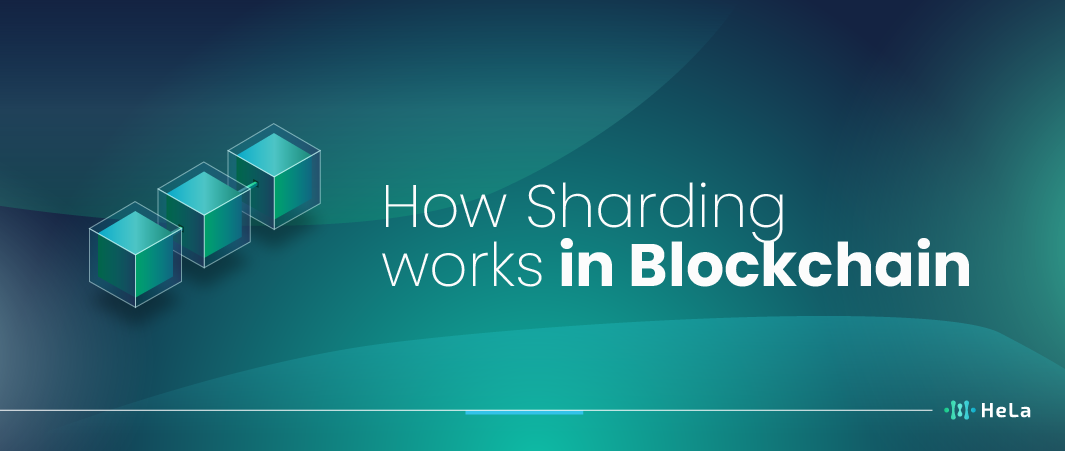As blockchain networks continue to grow in size and popularity, they face an increasingly urgent challenge: how to scale without sacrificing speed, security, or decentralization. One of the most promising solutions to this problem is sharding. In simple terms, sharding is a method of dividing a blockchain into smaller, more efficient parts — known as shards — that can process transactions and data in parallel.
By distributing the workload across these shards, blockchain networks can achieve much higher throughput and faster performance. In this article, we’ll dive into what sharding is, how it works, and why it’s considered a key innovation for the future of scalable blockchain ecosystems.
What is Sharding?

Sharding in blockchain is like organizing a big party where you want everyone to have fun, but your house isn’t big enough to have everyone in the same room. So, what you do is set up different areas or “shards” for guests to hang out in. Each area has its own music, snacks, and games, making it easier to manage the party and ensuring that everyone has a good time without overcrowding any one space.
In the world of blockchain, think of sharding as a way to throw a massive global party. Instead of one single place where all transactions happen, which can get really crowded and slow things down, sharding breaks the blockchain into smaller rooms or “shards”. Each shard handles its own mini-party of transactions, making the process much faster. It’s like having a team of friends helping you out at the party, where each one takes care of a group of guests.
Also Read: Zero-Knowledge Machine Learning (ZKML)
Sharding doesn’t just make things quicker; it also means that as more guests arrive, the party can keep growing without losing its fun. The blockchain can keep adding more shards. This is how sharding helps blockchains scale up smoothly, so more people can join in without any hassle. It’s all about having a good time efficiently, just like making sure everyone at the party gets their share of cake without a long wait.
The Scalability Problem in Blockchain Networks
One of the most critical challenges facing blockchain technology today is the problem of scalability. In traditional blockchain networks like Bitcoin and Ethereum, every node is required to store the entire history of transactions and validate each new transaction individually. While this approach ensures high security and decentralization, it also creates a significant bottleneck as the network grows.
When millions of users interact with decentralized applications (dApps), process smart contracts, or transfer digital assets simultaneously, the system can become congested. This results in slow transaction speeds, delayed confirmations, and skyrocketing transaction fees, making the network less efficient and less appealing for both developers and users.
Scalability limitations hinder the ability of blockchain platforms to support mass adoption across industries such as finance, gaming, healthcare, and supply chain management. Without scalable solutions, blockchains risk losing their competitive edge to faster, more centralized systems, ultimately undermining the very principles of decentralization and trust they were built upon. Addressing scalability is not just an optimization — it is a necessity for blockchain’s future survival and growth.
How Sharding Works in Blockchain

Sharding is a database architecture pattern that separates larger databases into smaller, faster, more easily managed parts called shards. The individual shards are each a discrete database, and together they form a single logical database. Here’s how sharding works in the context of blockchain technology:
Division of Data
In a sharded blockchain, the entire state of the network, including the blockchain’s transaction history, account balances, and smart contract states, is divided into partitions known as shards. Each shard contains a portion of the state and transaction history of the entire blockchain.
Node Assignment
Nodes are the individual participants of the blockchain network, usually servers or computers that hold copies of the blockchain’s state. In a sharded system, nodes are assigned to specific shards, rather than maintaining a copy of the entire blockchain. This means that each node only processes transactions for its assigned shard.
Parallel Processing
Because each shard operates independently, transactions can be processed in parallel rather than sequentially. This parallel processing capability is the key to increasing the transaction throughput of the blockchain.
Cross-Shard Communication
Even though shards operate independently, they sometimes need to communicate with each other. For instance, if a transaction involves accounts that are located on different shards, the system needs to facilitate communication between these shards to validate and complete the transaction.
Consensus Mechanism
Each shard may have its own consensus mechanism, which can be the same or different from those of other shards. The consensus mechanism is a set of rules that the nodes in a shard use to agree on the state of the shard’s blockchain.
Security Considerations
Sharding can introduce new security considerations, as each shard may be more vulnerable to certain attacks compared to the entire network. Therefore, sharded blockchains need to implement security measures to protect against such vulnerabilities.
Scalability Benefits
Sharding is primarily used to scale the blockchain’s capacity. By dividing the workload among multiple shards, the network can handle more transactions per second, improving the blockchain’s scalability and performance.
In essence, sharding allows a blockchain to scale horizontally by adding more shards as the number of transactions increases, without compromising on speed or requiring nodes to have higher processing capabilities. It’s a way to accommodate growth and increase efficiency in blockchain networks.
Benefits of Sharding

Sharding is a database partitioning technique widely adopted in blockchain technology to enhance its scalability and security. Here are some of the benefits:
1. Increased Scalability
Sharding divides the blockchain network into smaller, more manageable pieces, or “shards,” each capable of processing transactions independently. This division means that transactions can be processed in parallel, significantly increasing the throughput of the network. As a result, sharding can allow blockchains to scale horizontally and accommodate more users and transactions without suffering from the bottlenecks that can occur in a traditional, unsharded blockchain.
2. Enhanced Network Performance
By distributing the transaction load across multiple shards, the network can achieve higher performance levels. It reduces latency because each shard has fewer nodes to reach consensus, and transactions can be confirmed more quickly. This can lead to faster transaction times and a smoother user experience.
3. Improved Security
Sharding can also offer security benefits. If one shard is compromised, the attack is contained to that shard alone, protecting the rest of the network from the breach. This compartmentalization of data and transactions can limit the damage and make it more difficult for an attacker to compromise the entire network.
4. Decentralization and Redundancy
With sharding, there is no single point of failure. Each shard operates independently and can maintain the network’s functionality even if other shards are experiencing issues. This contributes to the robustness and fault tolerance of the network.
5. Resource Efficiency
Sharding allows the network to make efficient use of resources. Nodes in a shard only need to process and store information for their shard, not the entire network. This can decrease the hardware requirements for nodes and make it more feasible for individuals to participate in the network, enhancing decentralization.
6. Network Maintenance
The maintenance and upgrading of a blockchain can become more manageable with sharding. Instead of updating the entire network at once, updates can be rolled out shard by shard, which can minimize downtime and disruption.
Sharding presents a solution to some of the most pressing issues facing blockchain technology today, primarily scalability and security. Its implementation could be a significant step toward achieving mass adoption of blockchain technology.
Challenges and Considerations
While sharding holds tremendous promise, it’s not without its challenges and considerations. Ensuring that shards operate securely and without interference is crucial. Moreover, maintaining consensus among shard nodes and managing inter-shard communication can be complex tasks. Developers and network stakeholders must carefully plan and implement sharding strategies to address these challenges effectively.
Security
Each shard operates independently, holding a fraction of the database’s total data. This means the security measures must be replicated across each shard to prevent unauthorized access or data breaches. Ensuring that the security protocols are consistent and strong across all shards is a considerable challenge.
Interference
Sharding can lead to potential interference issues, where one shard’s operations affect another’s. This can happen due to poorly designed sharding schemes or unintended interactions between shards, leading to data integrity issues or performance bottlenecks.
Consensus Among Nodes
In distributed systems, consensus algorithms are crucial to ensure that all nodes, or shards in this case, agree on the state of the system. This becomes more complex in a sharded system because you need to maintain consensus not only within each shard but also across the shards.
Inter-Shard Communication
Shards need to communicate with each other to process transactions that span multiple shards. This communication must be efficient to prevent the system from becoming bottlenecked by inter-shard traffic. Managing this communication effectively is a technical challenge that requires careful planning and implementation.
Complexity in Implementation
Sharding introduces complexity in database management. Implementing a sharding strategy requires careful planning, a deep understanding of the data, and the way it will be accessed, to ensure that the database continues to operate efficiently after it has been sharded.
Data Distribution and Balancing
Determining how to distribute data across shards is non-trivial. Poor distribution can lead to some shards being heavily loaded while others are underutilized, leading to imbalanced system load and potential performance issues.
Operational Complexity
Managing a sharded database system can be more complex operationally. Tasks like backups, monitoring, and troubleshooting become more involved because they need to be performed across multiple shards.
Scalability Versus Complexity Trade-Off
While sharding can provide scalability, it also adds complexity to the system. There is a trade-off between the desired scalability benefits and the added complexity in terms of development, deployment, and maintenance.
To address these challenges effectively, developers and network stakeholders must adopt robust sharding strategies that include:
- Intelligent shard key selection to ensure even data distribution.
- Strong and consistent security measures across all shards.
- Efficient consensus algorithms suited for sharded architectures.
- A comprehensive plan for inter-shard communication that takes into account the increased network traffic.
- Tools and procedures for operational management that cater to the needs of a sharded environment.
How Sharding Transforms Ethereum 2.0
In the context of Ethereum 2.0, sharding is a fundamental upgrade designed to solve the network’s long-standing scalability issues. Instead of relying on a single chain where every node must process every transaction, Ethereum 2.0 introduces a system where the blockchain is split into 64 smaller chains, known as shards.
Each shard operates independently, handling its own transactions, smart contracts, and data storage, while still communicating securely with the main network through a central coordinating chain called the Beacon Chain. By spreading the workload across multiple shards, Ethereum 2.0 can dramatically increase its transaction throughput, allowing the network to handle thousands of transactions per second rather than just a few dozen.
Also Read: What Is Mobile Development Stack?
This approach not only boosts efficiency but also reduces congestion and transaction fees, paving the way for Ethereum to support mainstream adoption in areas like DeFi, gaming, and enterprise solutions. Sharding, combined with Ethereum’s move to a Proof-of-Stake (PoS) consensus mechanism, represents a major leap forward in creating a faster, greener, and more scalable blockchain ecosystem.
Sharding in Solana and Its Unique Approach
In the case of Solana, sharding takes on a different meaning compared to traditional blockchain designs like Ethereum 2.0. Rather than implementing sharding in the classical sense — splitting the blockchain into separate shards — Solana focuses on achieving massive scalability without breaking the network into smaller chains.
Solana’s unique approach uses innovations like Proof of History (PoH) and parallel transaction processing to scale efficiently on a single global state. This means all validators work together on one unified network without having to split the data into shards. However, as Solana’s ecosystem continues to expand and transaction volumes grow exponentially, the team has explored future possibilities of introducing local fee markets and dynamic scaling solutions that share some conceptual similarities with sharding — by reducing congestion in specific parts of the network.
While Solana does not use traditional sharding today, its architecture is built to scale horizontally if needed, offering an alternative vision for blockchain scalability without compromising composability and user experience.
Conclusion
In conclusion, sharding in blockchain technology represents a pivotal innovation that addresses one of the most pressing issues faced by blockchain networks today: scalability. By dividing the network into smaller, more manageable shards, sharding enables blockchain platforms to handle a vastly increased number of transactions while maintaining security and efficiency.
While challenges remain, the potential benefits of sharding are undeniable, as demonstrated by the ongoing efforts of major blockchain projects to incorporate this concept into their infrastructure. As the blockchain industry continues to evolve, sharding promises to play a pivotal role in shaping the future of scalable and efficient blockchain networks.
Blockchain technology is constantly evolving, and innovations like sharding are at the forefront of this transformation. As we look ahead, it is evident that sharding will contribute significantly to the growth and maturation of blockchain ecosystems, enabling them to meet the demands of a rapidly expanding user base and ushering in a new era of decentralized applications and services. Stay tuned as the blockchain industry continues to push the boundaries of what’s possible, with sharding leading the way towards a more scalable and efficient future.
Disclaimer: The information provided by HeLa Labs in this article is intended for general informational purposes and does not reflect the company’s opinion. It is not intended as investment advice or recommendations. Readers are strongly advised to conduct their own thorough research and consult with a qualified financial advisor before making any financial decisions.

Joshua Soriano
I am a writer specializing in decentralized systems, digital assets, and Web3 innovation. I develop research-driven explainers, case studies, and thought leadership that connect blockchain infrastructure, smart contract design, and tokenization models to real-world outcomes.
My work focuses on translating complex technical concepts into clear, actionable narratives for builders, businesses, and investors, highlighting transparency, security, and operational efficiency. Each piece blends primary-source research, protocol documentation, and practitioner insights to surface what matters for adoption and risk reduction, helping teams make informed decisions with precise, accessible content.
- Joshua Soriano#molongui-disabled-link
- Joshua Soriano#molongui-disabled-link
- Joshua Soriano#molongui-disabled-link
- Joshua Soriano#molongui-disabled-link

